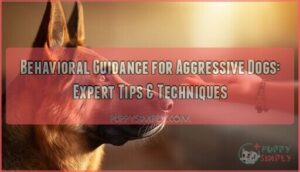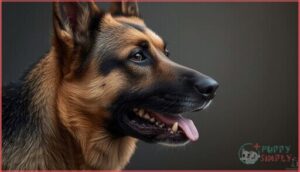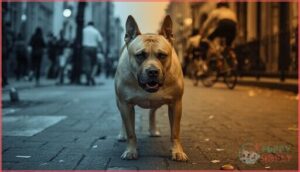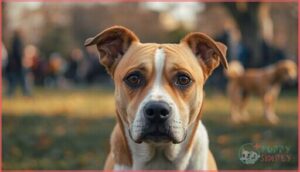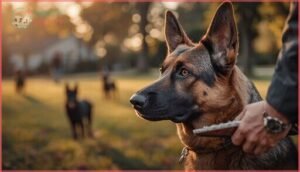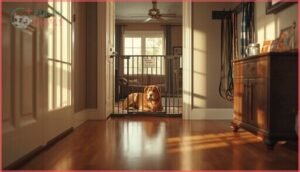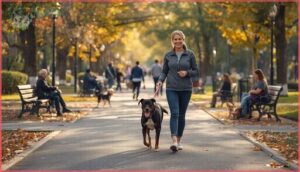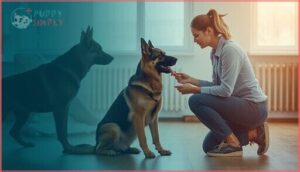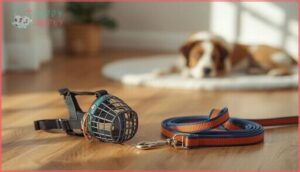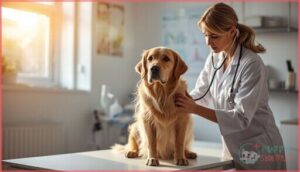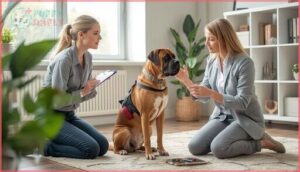This site is supported by our readers. We may earn a commission, at no cost to you, if you purchase through links.
A dog’s bite doesn’t begin at the teeth—it begins with a tightened mouth, a sideways glance, or a body frozen mid-motion. These subtle signals often go unnoticed until aggression erupts, leaving owners feeling blindsided and helpless.
Yet research shows that 60% to 70% of dog bites involve people the dog knows, suggesting these incidents aren’t random acts but predictable outcomes of missed communication. When you understand what drives aggressive behavior and recognize the warning signs your dog offers, you gain the power to intervene before fear or frustration escalates.
Effective behavioral guidance for aggressive dogs doesn’t start with correction—it starts with reading your dog’s emotional state and addressing the root causes that push them past their threshold. The right approach combines safety management, evidence-based training techniques, and professional support to rebuild trust and reduce risk.
Table Of Contents
- Key Takeaways
- Recognizing Early Signs of Aggression
- Common Causes of Aggressive Behavior
- Types of Aggression in Dogs
- Assessing Aggression Triggers
- Ensuring Safety at Home
- Managing Aggression in Public Spaces
- Behavior Modification Techniques
- Utilizing Management Tools Effectively
- The Role of Medical Assessment
- Working With Professional Behaviorists
- Frequently Asked Questions (FAQs)
- How do you deal with dog aggression?
- What is dog aggression?
- How do you modify aggressive dog behavior?
- Can a veterinary behaviorist help a dog deal with aggression?
- Is my dog aggressive toward other dogs?
- How do I know if my dog is aggressive?
- How to discipline a dog for being aggressive?
- How do I stop my dog’s aggressive behavior?
- Can aggression be trained out of a dog?
- What are 3 ways you can approach an aggressive dog?
- Conclusion
Key Takeaways
- Dog aggression is predictable rather than random, with 60-70% of bites involving familiar people and most dogs showing subtle warning signs like whale eye, frozen posture, or tight mouths before escalating to overt aggression.
- Fear and anxiety are the most common roots of aggressive behavior, accounting for 41% of referred cases, while underlying medical conditions like pain from arthritis or neurological disease trigger aggression in ways that training alone won’t fix.
- Effective behavior modification combines positive reinforcement training with desensitization and counterconditioning, avoiding punishment-based methods that research shows increase aggression risk by 2-3 times and cause stress behaviors in 65% of dogs.
- Managing aggressive dogs requires a multi-layered approach including trigger identification, environmental management with barriers and muzzles, structured daily routines, and professional support from certified behaviorists who use evidence-based protocols tailored to your dog’s specific patterns.
Recognizing Early Signs of Aggression
Dogs rarely snap out of nowhere—they’re almost always telling you something first. Before aggression escalates, your dog will show subtle warning signs that are easy to miss if you don’t know what to look for. Learning to read these early cues helps you step in before a situation gets out of hand.
Subtle Warning Cues in Dogs
Recognizing warning signs early can mean the difference between prevention and a bite. You might notice your dog’s mouth suddenly close tight, his eyes widen to show more white (“whale eye”), or his body go completely still. Lip licking, yawning, or a fixed stare often appear before growling. These subtle facial expressions, oral signals, and body postures are your dog’s way of saying “I’m uncomfortable”—aggressive displays often follow if you miss them.
Spotting early cues like whale eye, tense posture, or lip licking can prevent dog aggression before it escalates to a bite
Understanding a dog’s ear and tail positions can further clarify their emotional state.
Escalation Patterns and Predictability
Once you spot those early warning signs, you need to understand how quickly things can escalate. Not all dogs follow a predictable path. Research shows that 62% of aggressive dogs bit without barking or growling first, meaning vocal cues alone won’t protect you.
Here’s what shapes how fast aggression unfolds:
- Warning sign deficits – Many dogs skip straight to biting
- Trigger stacking – Multiple stressors pile up without recovery time
- Ladder dynamics – Repeated ignored signals teach dogs to escalate faster
- Risk factors – Fearfulness, intact status, and isolation increase unpredictability
Contextual modulation matters too. Your dog’s age, household size, and past experiences all influence whether aggressive displays appear gradually or seemingly out of nowhere. Larger dogs showed increased dangerousness. Understanding these patterns gives you control.
Differentiating Aggression From Play
Even if you’ve tracked escalation patterns, you may still mistake rough play for a genuine threat. Dogs showing aggression exhibit a stiff, rigid posture with hard staring, while playful dogs move with loose, bouncy energy and soft eyes. Play bow signals—forequarters down, hindquarters up—mark friendly intent. Watch for reciprocal play signs: healthy interactions include role reversals, with both dogs taking turns chasing. Vocal cue differences matter too. Playful barks sound higher-pitched and intermittent, while aggressive growls are deep and sustained.
Context and consent determine safety. If one dog repeatedly tries to escape but the other pursues relentlessly, consent is absent. Bite risk factors increase dramatically when dogs can’t be interrupted or redirected—loss of responsiveness signals a potential shift from play to aggression. Research shows dogs under one year are most prone to biting during play, emphasizing the need for early supervision.
| Play Behavior | Aggressive Behavior |
|---|---|
| Loose, bouncy movements with frequent pauses | Stiff, rigid posture with sustained intensity |
| Role reversals (chasing, being chased) | Persistent chasing or pinning without reversal |
| Responsive to interruption and recall cues | Unresponsive, difficult to redirect |
Monitor reciprocity carefully. Balanced dog interactions show both animals initiating and disengaging freely, whereas problematic play involves mounting, pinning, or resource guarding without mutual enjoyment.
Common Causes of Aggressive Behavior
Aggression doesn’t appear out of nowhere. Understanding what’s behind your dog’s reactive behavior is the first step toward helping them feel safer and more secure.
Let’s look at the most common triggers that can push a dog toward aggressive responses.
Fear and Anxiety Triggers
Fear and anxiety are the most common roots of aggression in dogs. When your dog feels trapped, overwhelmed, or unable to escape, defensive behavior can quickly escalate. Understanding what scares your dog is the first step toward safer interactions.
- Noise sensitivity affects up to 32% of dogs, with fireworks and thunderstorms triggering panic that can generalize to aggression
- Social fear emerges when dogs lack early socialization, making strangers or new environments feel threatening
- Handling aversion develops from restraint or invasive procedures like nail trims
- Breed predisposition means some dogs inherit lower fear thresholds, requiring fewer triggers to react
Pain and Medical Conditions
While behavior alone may seem like the problem, pain-based aggression is surprisingly common. A dog struggling with chronic discomfort won’t always limp or cry—instead, you might see snapping, avoidance, or sudden mood shifts. Medical conditions ranging from arthritis to neurological disease can trigger defensiveness long before diagnosis.
| Medical Problem Category | Common Conditions | Behavioral Signs |
|---|---|---|
| Musculoskeletal Pain | Hip dysplasia, elbow osteoarthritis, spinal disorders | Snapping when touched, reluctance to move, tense posture |
| Neurological Disease | Encephalitis, brain inflammation, spinal cord issues | Sudden aggression, disorientation, unpredictable reactions |
| Endocrine Impact | Hypothyroidism, hypoglycemia | Irritability, mental dullness, episodic outbursts |
| Underlying Pain | Dental disease, undiagnosed injuries | Growling during handling, food guarding, withdrawal |
| Medical Mimics | Infections, organ dysfunction | Changes in eating, sleeping, elimination, and social behavior |
In one study, musculoskeletal pain accounted for 75% of aggression cases with medical factors. Among child-directed aggressive dogs, underlying pain was the primary diagnosis in 14% of cases. Neurological factors and endocrine impact often go undetected until thorough medical assessment reveals the root cause.
Treatment effects can be dramatic. When pain is correctly identified and managed, aggressive incidents often decrease markedly. That’s why a thorough veterinary exam—including bloodwork, imaging, and orthopedic evaluation—is essential before assuming aggression stems purely from behavior. Medical problems won’t resolve with training alone.
Resource Guarding and Territoriality
When your dog freezes over a toy or lunges at the fence line, you’re witnessing resource guarding or territorial behavior—patterns influenced by genetic predisposition and early socialization. Surveys show 15–45% of dogs guard food, toys, or space, while inadequate boundary management allows rehearsal that strengthens dog aggression in the yard.
Behavior modification using desensitization reduces dog aggression over food when medical influence is ruled out first.
Environmental and Social Factors
Where your dog lives shapes behavior more than you might expect. Rural dogs show heightened stranger-directed aggression, while household density and restricted social exposure during puppyhood increase risk considerably.
First-time owner experience, disrupted daily routine, and limited dog socialization all heighten environmental triggers.
Environmental management—structured social interactions, consistent schedules, and gradual public exposure—helps prevent aggression before warning signs emerge.
Types of Aggression in Dogs
Aggression doesn’t look the same in every dog because the underlying motivation changes the behavior you’ll see. Understanding which type your dog is displaying helps you respond appropriately and avoid making things worse.
Let’s break down the four most common forms of aggression you’re likely to encounter.
Fear-Based Aggression
When your dog can’t escape what scares them, aggression often becomes their last line of defense. Fear-based aggression accounts for 41% of referred cases, making it the most common type. You’ll recognize it by:
- Defensive postures like crouching or tucked tails
- Triggered flight responses blocked by barriers
- Behavioral issues rooted in inadequate early socialization
- Trigger stacking that shortens the fuse over time
Genetic predisposition combined with limited exposure before 12 weeks dramatically increases risk.
Protective and Territorial Aggression
When your dog treats doorways or yards like fortress walls, you’re seeing territorial aggression—reported in 29% of behavior cases. Protective aggression kicks in when unfamiliar people approach family members. Certain guarding breeds show higher predisposition, but environment matters more.
Watch for predictable warning sequences at gates and thresholds. Management strategies focus on controlled introductions and systematic desensitization to reduce threat perception without punishment.
Possessive and Resource Guarding
Resource guarding behavior occurs when your dog stiffens, growls, or snaps around food bowl aggression, toy guarding, or space protection. This accounts for roughly 32% of aggression cases.
Value assessment matters—high-value chews trigger stronger reactions. Handling escalation with punishment increases danger.
Identifying aggression triggers through observation helps you build effective behavior modification techniques and dog behavior treatment plans focused on desensitization rather than confrontation.
Redirected and Barrier Aggression
When arousal overwhelms your dog—picture frantic barking at a window or lunging on leash—that energy sometimes lands on the nearest target. Redirected frustration and leash barrier aggression turn quickly. Multi-dog households see bites during conflicts when you intervene. Barrier frustration shortens the fuse from trigger to bite.
Understanding Redirection Targets and Thresholds:
- Arousal thresholds drop rapidly behind fences or leashes, making dogs react faster
- Frustration tolerance diminishes when your dog can’t reach the original stimulus
- Silent attacks occur since redirection bypasses typical warning signals
- Physical separation without tools raises your risk of becoming the redirected target
Assessing Aggression Triggers
Understanding what sets off your dog’s aggression is the first step toward managing it effectively. Triggers can include specific people, other animals, certain environments, or even particular times of day.
To build a clear picture of your dog’s behavior, you’ll need to identify patterns, track incidents, and recognize the context behind each episode.
Identifying People, Animals, and Situations
Pinpointing the who, what, and where behind your dog’s aggression is like assembling puzzle pieces—each detail reveals the bigger picture. Survey data show that 60% to 70% of bites involve familiar people, not strangers.
You’ll need to identify human-related triggers, animal-related triggers, and situational contexts. Watch for early warning signals like stiffening or hard stares when specific handling aggression scenarios arise, noting every sign of aggression and aggression type you observe.
Understanding Contextual Patterns
Once you’ve spotted individual triggers, you need to look at the bigger picture. Household dynamics—like whether you’re a first-time owner or your dog lives alone—shape aggression risk considerably.
Environmental stressors such as lack of yard space or indoor-only life can double bite likelihood. Human interaction patterns, including energetic play or bedroom proximity, and dog demographics like age, sex, and size all combine.
Life history factors interact with current context, lowering thresholds for canine aggression and guiding targeted behavior modification.
Keeping an Aggression Log
To turn those observations into action, you need to write down every incident. An aggression log captures when, where, and who was involved—target identification and context analysis that reveal temporal patterns you might otherwise miss.
Record incident severity, from a hard stare to broken skin. Over weeks, your entries track treatment impact, sharpen your dog training plan, and guide behavioral training techniques specific to your dog’s canine aggression triggers.
Ensuring Safety at Home
When you’re living with an aggressive dog, your home needs to be a place where everyone feels secure. That means putting smart safeguards in place to prevent incidents before they happen.
Let’s look at three essential strategies that will help you create a safer environment for your family and your dog.
Using Physical Barriers and Crates
Physical barriers and crates provide essential containment when you can’t supervise your dog directly. Baby gates, exercise pens, and closed doors prevent unsupervised access to triggers in multi-dog homes.
Proper crate introduction with positive reinforcement creates a safe den, though confinement stress and welfare concerns require monitoring.
Basket muzzles add another layer during controlled exposure, ensuring safe handling while you work on behavior modification.
Managing Interactions With Family
When aggression surfaces toward household members, structured family education becomes your first line of defense. Research shows that over half of dog bites happen at home, often when familiar people unknowingly trigger fear or frustration.
To protect family members and reduce risk:
- Teach everyone to recognize early warning signs like freezing or hard stares
- Establish consistent routines for feeding, exercise, and rest periods
- Require adults to supervise all dog interactions with children
- Use positive interactions—rewarding calm behavior rather than confronting the dog
- Manage shared space carefully, preventing access to triggers like food bowls or resting spots
Safety guidelines for aggression emphasize predictability and respect.
Supervising Children and Vulnerable Members
Without active supervision, 89% of pediatric dog bites still occur even when adults are present. You need to recognize that presence doesn’t equal protection—your quality of supervision matters most.
Environmental controls like barriers and leashes prevent contact between children and dogs with aggressive histories. When risk assessment shows family members can’t safely follow safety guidelines for aggression, rehoming considerations become part of ensuring dog safety for vulnerable household members.
Managing Aggression in Public Spaces
Taking your dog into public spaces requires a different approach than managing aggression at home. You’ll need practical tools and strategies that keep everyone safe while you work through behavioral challenges.
Let’s look at the key techniques that can help you navigate walks, parks, and other outdoor environments with confidence.
Leash and Muzzle Training
When you’re managing dog aggression outdoors, proper leash and muzzle training becomes your safety anchor. Training with positive reinforcement works—reward-based methods show higher obedience than aversive leash corrections, which triggered aggression in 63% of cases.
- Start muzzle introduction gradually: Use food during training to decrease avoidance behaviors and build trust
- Choose basket muzzles: They allow panting and treat intake while maintaining safety
- Monitor for fit issues: Roughly 29% of muzzles impair mouth opening or proper nose distance
- Practice leash skills consistently: Group classes reduced leash pulling considerably during owner interaction periods
Training outcomes improve when you use structured, positive approaches rather than corrections alone.
Avoiding High-Risk Situations
Think of trigger avoidance as your first line of defense—you’re actively steering clear of situations that could spark aggression. Avoid crowded sidewalks, dog parks, and areas where past incidents occurred.
Schedule adjustments matter: walking during low-traffic hours reduced reactive outbursts in two-thirds of cases. Route modification keeps your dog away from known conflict zones, while barrier strategies and muzzle introduction add safety layers when high-risk exposure is unavoidable.
Responding to Triggers Outdoors
When your dog locks onto a trigger outdoors, your immediate response sets the tone for success. Distance management is your most powerful tool—repositioning behind a parked car or crossing the street keeps your dog under threshold. Here’s your action plan:
- Increase distance immediately at the first sign of stiffening or staring
- Deliver high-value treats to create positive counterconditioning outdoors
- Use your leash techniques to execute a smooth U-turn away from the trigger
Basket muzzles add an important safety layer during unavoidable encounters, while environment control through strategic route selection reduces aggression triggers altogether.
Behavior Modification Techniques
Changing aggressive behavior takes more than just managing your dog’s environment. You need to actively teach your dog new ways to respond to triggers and build their confidence over time.
The following techniques form the foundation of successful behavior modification programs.
Positive Reinforcement Training
When your dog faces the world with fear or frustration, reward-based efficacy offers a proven path forward. Positive reinforcement training focuses on rewarding calm behavior rather than punishing reactions. This approach builds trust, strengthens your relationship, and reduces stress-related behaviors by up to 57%. Clicker applications mark exact moments of success, accelerating learning. Training consistency ensures lasting progress while improving welfare outcomes for both you and your dog.
| Method Type | Stress Indicators | Aggression Risk |
|---|---|---|
| Reward-based | Low body posture: 8% | Baseline |
| Mixed methods | Moderate stress signs | 2.2× toward strangers |
| Aversive-based | Crouching: 3.56 mean | 2.9× toward family |
| Positive-only | Mouth-licking: 8% | Lowest scores |
| Discipline-based | Stress behaviors: 65% | Elevated across types |
Desensitization and Counterconditioning
Reward-based efficacy sets the stage—now you can improve your dog’s emotional responses through desensitization and counterconditioning. Pairing gradual exposure with positive reinforcement has achieved up to 100% improvement in fear-driven aggression when both techniques work together.
Protocol design starts below your dog’s reaction threshold, then carefully increases intensity as calm behavior emerges. Efficacy research confirms this behavior modification approach outperforms tools alone while improving safety measures and emotional outcomes.
Consistency and Structured Routines
Building on gradual exposure, predictable schedules and consistent responses form the backbone of any professional plan. Dogs thrive when household rules stay the same across all family members—exercise integration at set times, structured routines for feeding and rest, and uniform handling during training sessions. This framework reduces confusion and stress, letting positive reinforcement work more effectively while you maintain a routine that fosters lasting behavior change.
- Set fixed times for walks, meals, and training to lower cortisol and prevent stress-driven outbursts
- Assure every household member enforces the same rules to avoid mixed signals that trigger aggression
- Integrate exercise into your daily schedule to reduce frustration and excess energy
- Use consistent positive reinforcement for calm behavior rather than unpredictable corrections
- Establish clear boundaries for furniture, doorways, and resources to minimize conflict
Utilizing Management Tools Effectively
Managing aggressive behavior isn’t just about training—it’s also about using the right tools to keep everyone safe while you work on long-term solutions. The right equipment can prevent incidents, reduce stress for both you and your dog, and create space for positive change to happen.
Let’s look at three essential management tools that can make a real difference in your daily routine.
Leashes, Head Halters, and Tethers
Choosing the right equipment can mean the difference between a safe walk and a dangerous encounter. Leashes and head halters give you important control over leash reactivity, letting you redirect your dog’s attention before aggression escalates. Studies show head halters reduce lunging by 30–40% compared to flat collars.
However, avoid prolonged tethering—chained dogs are nearly three times more likely to bite. Halter acclimation requires patience, but proper equipment choice and safe handling protect everyone.
Basket Muzzles for Safety
A properly fitted basket muzzle is your insurance policy in unpredictable moments. Unlike fabric muzzles, basket designs allow panting and drinking—critical for safe handling during vet visits or public outings.
Nearly 80% of owners report muzzle use at some point, yet poor fit compromises welfare in about 29% of cases. Gradual training over two to four weeks ensures acceptance and prevents distress, turning this safety tool into a stress-free routine.
Environmental Enrichment Strategies
When dogs receive auditory stimulation like classical music alongside social interaction and puzzle feeders, you create a calm environment that lowers baseline arousal. Olfactory enrichment through scent-work engages your dog’s mind.
A multi-modal approach combining play, training, and environmental modification tackles dog anxiety holistically. This layered dog behavior modification strategy aids dog training by reducing hypervigilance before triggers arise.
The Role of Medical Assessment
Before you assume your dog’s aggression is purely behavioral, it’s important to rule out medical causes. Pain, illness, and neurological conditions can trigger or worsen aggressive responses in ways that training alone won’t fix.
A thorough veterinary assessment is your first step toward understanding whether your dog’s behavior has a physical foundation.
Veterinary Exams for Underlying Issues
Before you jump into behavior training, a thorough veterinary exam is essential. Medical conditions like pain from arthritis, neurological disease, or endocrine disorders can trigger or worsen aggression.
Your veterinarian will conduct a diagnostic workup including physical assessment, blood tests, and pain assessment to rule out underlying health issues. VetApproved medical assessment for dogs ensures any medication impact or neurological signs are identified before you move forward with behavioral strategies.
When to Consider Medication
When behavior modification alone doesn’t reduce the safety risk, medication may be necessary. If your dog’s emotional distress or anxiety remains high despite consistent training, or if failed interventions leave you unable to manage aggression safely, consult your veterinarian or a veterinary behaviorist.
They’ll help establish treatment goals and provide professional oversight to make certain medication complements—not replaces—your behavior plan.
Monitoring Health During Training
Training places real demands on your dog’s body and mind. Track stress markers through appetite, sleep quality, and recovery times between sessions.
Schedule veterinary recheck schedules to monitor medical conditions and assess how behavior change logs align with physical health. Communication during training between you and your vet makes training load balance aids progress without overwhelming your dog.
Regular dog health checkups catch medical assessments for dogs’ needs early, keeping stress manageable throughout the behavior modification process.
Working With Professional Behaviorists
When aggression reaches beyond what you can handle on your own, bringing in a certified professional isn’t a sign of failure—it’s a smart move toward real progress. The right behaviorist will assess your dog’s specific triggers, design a plan that actually fits your household, and walk with you through each step of the process.
Let’s look at what working with a professional involves and how to make the most of that partnership.
Choosing Qualified Trainers or Behaviorists
Finding the right professional can feel overwhelming, but your dog’s safety depends on it. Look for certified trainers or veterinary behaviorists who rely on reward-based training methods, as research shows aversive techniques increase stress and compromise welfare.
Consider these qualifications:
- CPDT-KA – requires 300 documented training hours and exam
- IAABC-CDBC – behavior consultant certification
- CAAB – Certified Applied Animal Behaviorist credential
- Veterinary behaviorist – board-certified specialist (roughly 100 worldwide)
- KPA-CTP – Karen Pryor Academy training partner
Unfortunately, dog training remains largely unregulated in many regions, allowing anyone to claim expertise. Specialist availability is limited, so you may need teleconsultation for complex aggression cases.
Developing a Tailored Treatment Plan
Once you’ve chosen a qualified professional, they’ll conduct a thorough behavior assessment to map your dog’s triggers and patterns.
A strong behavior treatment plan combines technique selection—often desensitization and positive reinforcement training—with owner education on identifying triggers and staying consistent.
For complex cases, pharmacologic options may support behavior modification, and defining goals with measurable timelines keeps your dog training plan on track.
The Importance of Ongoing Support
After your plan is in place, progress isn’t automatic—it depends on consistent monitoring and adjustment with expert support for dog behavior. Studies show 86.8% of owners reported improvement when behavior consultants provided ongoing professional oversight.
Long-term gains require addressing adherence challenges, reducing relinquishment risk through social support, and refining strategies with professional intervention for dogs as your dog’s needs evolve.
Frequently Asked Questions (FAQs)
How do you deal with dog aggression?
You deal with dog aggression through a combination of trigger identification, behavior modification using positive reinforcement training, safe handling tools, home safety protocols, and professional collaboration with certified behaviorists or trainers.
What is dog aggression?
Dog aggression is communication signaling threat, fear, or stress. It ranges from subtle cues like freezing to overt behaviors like biting.
Understanding these triggers helps you manage risks and respond appropriately.
How do you modify aggressive dog behavior?
You modify aggressive behavior through structured behavior modification programs combining positive reinforcement training, desensitization, and counterconditioning.
Short, frequent training sessions paired with habituation protocols, communication strategies, and when needed, medication integration produce measurable improvements.
Can a veterinary behaviorist help a dog deal with aggression?
Yes—veterinary behaviorists are highly effective. In one survey, 81% of owners reported beneficial outcomes.
These professionals assess medical causes, create specific behavior treatment plans, recommend medication options when needed, and apply proven training approaches for long-term success.
Is my dog aggressive toward other dogs?
Stiff posture, raised hackles, hard staring, and persistent growling signal dog-dog aggression—not play. Nearly half of dogs show aggression toward unfamiliar dogs. Early warning signs require professional evaluation to guarantee safety.
How do I know if my dog is aggressive?
Your dog isn’t just in a “mood” when their entire body goes rigid like a statue—they’re broadcasting discomfort.
Watch for subtle warning signs like whale eye, lip curling, or freezing before overt aggressive behaviors escalate.
How to discipline a dog for being aggressive?
Don’t punish your dog for aggression. Punishment escalates fear and worsens behavior. Instead, use positive reinforcement, desensitization, and professional guidance to identify the underlying reason and build trust safely.
How do I stop my dog’s aggressive behavior?
Stopping aggression requires behavior modification through positive reinforcement, trigger avoidance, and training consistency. Medical assessment rules out pain, while professional help designs custom plans.
In severe cases, medication options support long-term dog behavior modification and safety.
Can aggression be trained out of a dog?
You can’t technically “cure” aggression, but—like tuning a vintage radio—you can reduce it considerably with positive training methods, behavior modification and management, and professional guidance needed to set realistic outcome expectations.
What are 3 ways you can approach an aggressive dog?
You can’t safely approach an aggressive dog yourself. Instead, remain calm, keep a safe distance, and contact professional intervention.
Dog owners using proper body language, muzzle introduction, and expert guidance guarantee dog safety for everyone.
Conclusion
An ounce of prevention is worth a pound of cure—especially regarding your dog’s safety and yours. Behavioral guidance for aggressive dogs isn’t about dominance or quick fixes; it’s about understanding triggers, creating structure, and responding with patience.
With the right tools, professional support, and commitment to consistency, you can transform fear and frustration into trust. The path forward requires effort, but the reward—a calmer, more confident companion—is worth every step.
- https://www.askavet.com/
- https://www.pumpkin.care/blog/dog-aggression-training/
- https://www.nature.com/articles/s41598-018-25671-7
- https://www.avvets.com/sites/site-4271/documents/Overflow%20of%20aggression%20dogs.pdf
- https://www.steventituslaw.com/blog/how-a-dogs-body-language-can-indicate-a-coming-attack/

